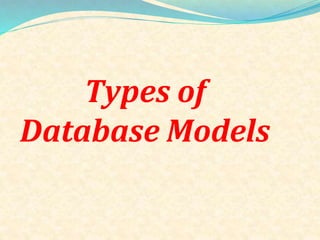
Type of database models
- 2. Data Model Describes structure of the database. Aim is to support the development of information systems by providing the definition and format of data. Classification: 1. High-Level Model 2. Representation Model 3. Low-Level Model
- 3. 1. High-Level Model • Ensures data requirement of the users. • Not concerned with representation, but it‘s a conceptual form. • Three Impotant terms: a)Entity: - Any object, exists physically or conceptually. b)Attribute:- Property or characteristic of entity. c)Relationship:- Association or link b/w two entities. • These 3 terms make Entity-Relationship Model.
- 4. Widely accepted and adapted graphical tool for data modeling. Introduced by Chen in 1976. Graphical representation of entities and their relationships in a database structure. Entity-Relationship (E-R) Model
- 5. Entity-Relationship (E-R) Model College Principal College Student C Student A Student B College 3 College 2 College 1 Course C Course B Course A Student CourseAdmission Stud_Name Stud_Roll No Course_Id Course_Name Relationships E-R diagram
- 6. •Advantages –Exceptional conceptual simplicity –Visual representation –Effective communication tool –Integrated with the relational data model •Disadvantages –Limited constraint representation –Limited relationship representation –No data manipulation language –Loss of information content
- 7. 2. Representation Model - Representation of data stored inside a database. - Describes the physical structure of the database. - It uses the concepts which are close to the end-users. - Classification: a. Hierarchical b. Relational c. Network
- 8. a. Hierarchical Database Model • Developed by IBM, is the Oldest database model. • Represented using a tree-diagram. (Parent-child relationship) • Each box is called a "Node" • The nodes represent a record type. • A line connecting nodes represent the link. Director Manager (Market.) Man (Sa ager les) Manager (HR) Area Manager 1 Area Manager 2 Area Manager 3 Sales Exe. 1 Sales Exe. 2 Sales Representative
- 9. Cont… • Parent-child type is suited for One-to-many relationship between two entities. • But difficult to implement many-to-many relationship. e.g.: IMS system from IBM. Director Manager (Market.) Man (Sa ager les) Manager (HR) Area Manager 1 Area Manager 2 Area Manager 3 Sales Exe. 1 Sales Exe. 2 Sales Representative
- 10. Advantages:- –Conceptual simplicity –Database security –Data independence –Database integrity –Efficiency Disadvantages:- –Complex implementation –Difficult to manage –Lacks structural independence –Complex applications programming and use –Implementation limitations –Lack of standards
- 11. b. Relational Database Model • Simplest and the most common model. • Developed in 1970 by E.F. Codd, it became commercial in the 80s. • Data elements are stored in different tables made up of rows and columns. Roll No Name Surname Section 1001 Rajkumar Tomar D 1002 Rajkumar Singh D
- 12. Relational Database Model(Cont) • Terminologies: -Data Values: alphanumeric raw data (Rajkumar) -Columns: fields (item or object that holds the data) -Rows: record (a group of data for related field) -Table: collection (all records & fields) -Key: identifier (uniquely identifies a row in the table. It can be value of a single or multiple column. e.g.: DB2, ORACLE, SQL Server. Roll No Name Surname Section 1001 Rajkuma r Tomar D 1002 Rajkuma r Singh D
- 13. • Advantages –Structural independence. –Improved conceptual simplicity. –Easier database design, implementation, management, anduse. –New technology performance power and flexibility with multiple data requirement capabilities. –Data security (strong privacy) –Powerful database management system. • Disadvantages –Substantial hardware and system software overhead. –Can facilitate poor design and implementation. –May promote “islands of information” problems.
- 14. c. Network Database Model • Represented using a Data-Structure Diagram. • Boxes represents the records & lines the links. • Based on "owner-member relationship" • Can represent one-to-one and many-to-many as well. Teacher 1 Teacher 2 Teacher 3 Course A Course B Course C Student 1 Student 2 Student 3
- 15. • Advantages –Conceptual simplicity –Handles more relationship types –Data access flexibility –Promotes database integrity –Data independence • Disadvantage –Difficult for first time users –System complexity –Lack of structural independence
- 16. DatabaseModels:- 1) Network model 2) Hierarchical model 3) Relational model 4)Entity-Relationship data model (mainly for database design) 5)Object-based data models (Object oriented and Object-relational) 6) Semi-structured data model (XML)
- 18. The Object OrientedModel •Semantic data model (SDM) developed by Hammer and McLeod in 1981 •Modeled both data and their relationships in a single structure known as an object •Basis of object oriented data model (OODM) •OODM becomes the basis for the object oriented database management system (OODBMS)
- 19. Object Oriented DataModel— Basic Structure• Object: abstraction of a real-world entity. • Attributes describe the properties of an object. •Objects that share similar characteristics are grouped in classes. • Classes are organized in a class hierarchy. •Inheritance is the ability of an object within the class hierarchy to inherit the attributes and methods of classes above it.
- 20. • Diagram:-
- 21. •Advantages –Adds semantic content –Visual presentation includes semantic content –Database integrity –Both structural and data independence •Disadvantages –Slow pace of OODM standards development –Complex navigational data access –Steep learning curve –High system overhead slows transactions –Lack of market penetration
- 22. Object-Relational DataModel • The new, extended version of relational database technology called object- relational database management systems also known as ORDBMS. • An ORDBMS supports an extended form of SQL called SQL3 that is still in the development stages. The extensions are needed because ORDBMSs have to support ADT's.
- 23. Advantages • large storage capacity, • access speed • manipulation power of object databases. • Disadvantages • The architecture of ORDBMS is not appropriate for high-speed web applications. • ORDBMS are set to conquer the database market.
- 25. Thanks
- 26. Introduction to File https://www.slideshare.net/San thiNivas/introduction-to-file- system File System Vs Database https://www.slideshare.net/Santh iNivas/file-system-vs-database
- 27. II BCOM CA A Attendance LInk - https://forms.gle/4sNPcG2vsNbDY Le56 II BCOM CA B Attendance Link - https://forms.gle/qodQZphkMkhw rTbCA